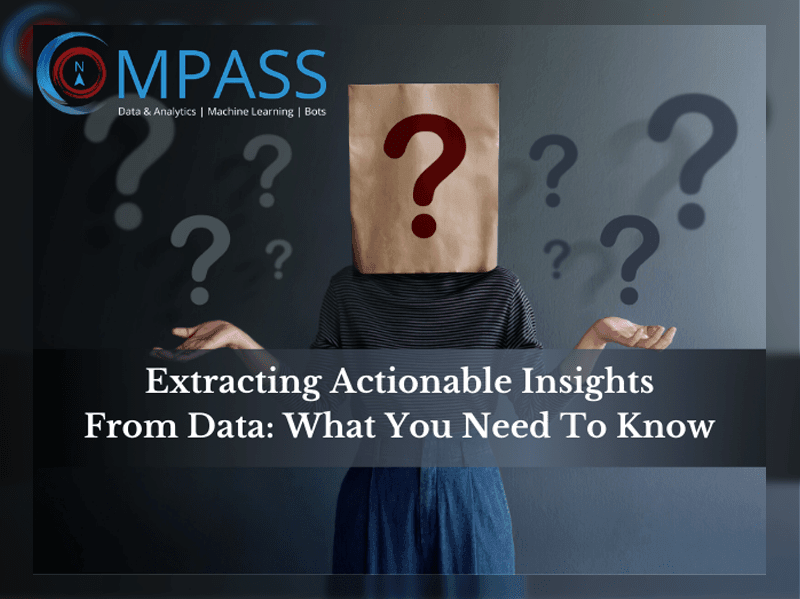While organizations today generate and capture a vast amount of raw data, they fail to effectively harness the potential business of this data. Extracting insights from raw data and making data-driven decisions has now become pertinent to organizations around the world.
That means if you want to get ahead of your competitors and stay relevant in the industry, then extracting actionable insights from data is not an option anymore — it is a necessity.
Given the misuse of the word by several analytics vendors, let’s first establish what an “insight” is and isn’t.
- Data: Raw facts and figures that aren’t processed and prepared. Data is usually stored in databases and spreadsheets. It is qualitative and quantitative.
Ex: Your marketing campaign generated an ROI of 10%. - Information: Data that is aggregated, provides more context and organized into a comprehensible format. Information is something you see on data visualizations and reports.
Ex: A data visualization chart showing marketing campaign ROI for the past 5 years. - Insights: Insights are obtained after analyzing information and drawing conclusions.
Ex: By running a TV ad, you can increase your campaign ROI by 4%.
A Step-by-Step Guide on How to Derive Insights from Data
1. Compile All The Raw Data
Information comes in different forms and formats. Your data can come from any kind of structured or unstructured sources. The first step is to compile all the data that you have including business data, scientific data, metrics and performance data, and data from social media platforms.
2. Reformat And Pre-Process Data
The data you have just compiled isn’t meaningful yet or even ready for processing. In this step, you need to reformat the data in a way that it becomes suitable for machine learning processing. For this, you would be required to perform decompressing, filtering or normalization on your data.
3. Clean Up To Make Sense Of Data
Even after pre-processing, data is still bound to have some gaps and imperfections. It might be inconsistent, dirty, or missing a few important values. You need to manually scourge through all the data values to find and rectify any inconsistencies. This step requires a lot of time and effort to ensure it is completely clean for the actual analysis phase.
4. Strategic Data Analysis
With your data carefully cleaned and transformed, it is now time to use data visualizations and statistical methods to uncover underlying patterns in the data. Clustering is a common machine learning technique used for statistical data analysis. It divides all the data points into different groups based on their common properties and features.
5. Find The Right Algorithms For Predictive Analysis
Depending on the characteristics of the groups formed in the last step, you need to pick an appropriate machine learning model to make predictions about insights and future trends. The correct model will depend on the type of input you have and the output that you require. You can also implement a few selected models to see which one produces the most accurate results.
6. Validate The Predictions
The next step is to validate the predictions and make sure they are accurate. For this, you need to match the observed data with the predictions to make sure it aligns.
It is crucial to evaluate and identify which model produces the best results for the given data set. Evaluating the performance of the different machine learning models can also help you identify the right model for the most accurate data insights. At the end of this step, you should have the ideal machine learning model and its accurate data predictions.
7. Make Better Data-Driven Decisions
You can transform the results into visual forecasting models or even decision trees to make the data easily understandable by all the stakeholders involved and make better business decisions.
From Data to Insights: How Brands Use Analytics to Drive Business Success
1. Coca-Cola Uses Insights For Customer Retention And Acquisitions
Consumers share opinions with the company through a wide number of mediums including phone, email, and social media. Coca Cola uses this raw data to understand its customers in a better way and create relevant content for different audiences on different platforms. For Coca Cola, the main objective is to use data to create branded content that aligns with its customer’s expectations.
2. Netflix Uses Big Data To Make Accurate Suggestions To Its Users
With over 100 million subscribers, Netflix is a great example of a company successfully using data analytics. The company gathers raw data from users’ past searches, watch patterns, ratings, view time, genre of shows, and percentage of rewatch in order to make accurate recommendations.
The recommendation system is responsible for 80 percent of the content streamed on Netflix which vouches for the accuracy of the insights.
3. Acuvate Helps A Fortune 500 Consumer Goods Company Leverage Data-Driven Insights To Reduce Trade Promotion Spend By $100k
40% of CPG trade promotion spending doesn’t drive the desired results. Our client faced a similar challenge and wanted to improve the effectiveness of trade promotions while reducing spending. With Acuvate’s help, the client captured and analyzed data from Nielsen analytics, past promotions, and various other internal and external sources.
This analysis provided insights and recommendations on what type of promotion to be run when, and where. They could also predict sales for different types of promotions.
As a result, the client was able to reduce trade promotion spend by $100k, reduced manual effort by 500 person-hours and increased revenue.
4. Spotify Uses Data Analytics To Create Personalized Playlists
The largest on-demand music streaming platform, Spotify also uses data analytics to create personalized playlists for its users called Discover Weekly.
To create Discover Weekly playlists, Spotify’s algorithm does the following:
- Comparing the type of music a user usually listens to with other users that have similar taste.
- Performing natural language processing over the lyrics of songs.
- Analyzing raw audio tracks to identify similar songs.
Final Words
Any data is only as good as the actionable insights and business value you derive from it. Thanks to modern BI technologies, organizations are now simplifying every process of transforming data into insights and thereby accelerating their journey towards making data work.
If you’d like to learn more about this topic, please feel free to get in touch with one of our data and analytics consultants for a personalized consultation.



